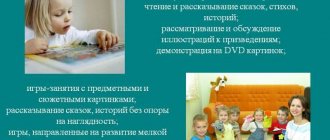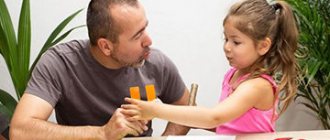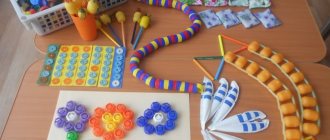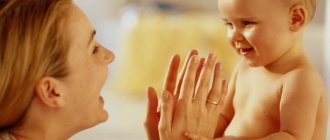A child’s speech is an indicator of his mental development. The more clearly and accurately he pronounces syllables and words, the faster those around him respond to his requests. An active vocabulary helps to better understand the world, quickly assimilate social norms, and develop memory and thinking. Psychologists do not recommend leaving this process to chance: parents should help the child master speech skills. Initially, children learn to speak by imitation. But if you work on the development of speech in children from 1 to 2 years old, the process can be significantly accelerated.
Speech development is an important milestone in the mental development of children 1-2 years old. It is important for parents to help children master speech skills, creating favorable conditions for the child’s development.
Norms of speech development in children 1-2 years old
For a child of 1 year of age, it is typical to master the following skills:
- repetition of open syllables. For example, a 1-year-old child cannot pronounce the word “no,” but reproduces it as “ne.” Or he says “yes”, “that”, etc.;
- ability to repeat sounds and syllables: pronounces sounds characteristic of animals - “av-av”, “mau”, “ko-ko”;
- expresses emotions with intonation;
- denotes objects and actions with syllables;
- perceives the names of objects, can point to them, understand what adults are talking about.
It is important not only what and how children 1-2 years old pronounce, but also the ability to remember the names of objects and their purpose.
Finger and gesture games
Scientists have found that in the brain, the nerve centers responsible for the movements of the fingers and hands are in close proximity to the areas of the brain responsible for the development of speech. Therefore, it is simply necessary to promote the active actions of the baby’s fingers and hands. Wonderful helpers in this matter are finger games, I have already written about them more than once; a complete list of interesting finger and gesture games, sorted by age, can be found here:
FROM 1 YEAR
FROM 1 YEAR 3 MONTHS
FROM 1 YEAR 6 MONTHS
FROM 1 YEAR 9 MONTHS
In addition to funny rhymes, it is very useful to learn simple gestures with your baby in the meantime, for example:
- To the question “How old are you?” We show the index finger - “1 year old”;
- We shake our index finger “Ay-ay-ay”;
- We show “yes” and “no” by moving our heads;
- We show “thank you” with a nod of the head;
- To the question “How are you doing?” We show our thumb - “Wow!” ("Great!")
- We depict how the bear walks (feet shoulder-width apart, trampling from foot to foot);
- We depict how a bunny jumps (arms in front of the chest, hands down, jump);
- We depict how a fox walks (wiggle its butt);
- We depict how a wolf clicks its teeth (we open and close our mouth wide, clicking our teeth);
- We depict how a butterfly flies (waving our arms, running around the room);
- We depict how an airplane flies (arms motionless to the sides, we run around the room);
- We depict how a duck walks (we move on our haunches).
- As we approach two years of age, we begin to learn a new answer to the question “How old are you?” and we train to show the index and middle fingers at the same time - “2 years old”. The same finger figure can be called “Bunny”
What does speech development depend on?
The development of a child’s speech depends on many factors: characteristics of physical development, emotional connection with parents.
The development of a child’s speech depends on 4 factors , including anatomical, physiological, emotional and social components:
- Emotional connection with parents: For young children, the presence of mother and father, grandparents, is important. Safety, predictability, understanding and respect for needs are all fertile grounds for overall development, including the conversational component.
- Satisfying the need to communicate with parents. First, nonverbal communication skills are formed - facial expressions, gestures, body movements, and then comes verbalization. Therefore, not only games are important for the development of speech - an emotional response to crying, fun, hugs, addressing the baby, calling him by name - all these are prerequisites for the child to begin learning to speak at the age of 1.
- Development of fine motor skills. There is a direct connection between the development of the speech centers of the brain and fine motor skills of the hands. Knowing this physiological feature, you can start the development of conversational skills through finger games and tactile palm analyzers.
- Formation of the speech apparatus: the correct anatomical structure of the tongue, palate, larynx and vocal cords are important prerequisites for the development of speech in children of the first years of life. Sometimes the delay in speaking skills is associated with incorrect positioning of the frenulum of the tongue: it is larger than necessary, and it does not reach the palate. In such cases, an incision of the frenulum is made under stationary conditions. The development of the circular muscles of the mouth and cheeks is also taken into account. With one-year-old children, you need to do more than just repeat sounds - it is important to teach them to drink from a straw, blow soap bubbles and rubber balls.
Only a harmonious combination of these four components guarantees the timely development of speech in children from 1 to 2 years old. Therefore, classes should include a set of different games, taking into account the characteristics of a child one year old and older.
Rules for speech therapy classes at home
The main advice for parents is an initial consultation with a speech therapist. If you notice a speech impediment in your child, first you need to show him to a speech therapist. Don’t worry if the speech therapist gives you recommendations to visit other specialists with your child - a psychiatrist, psychologist, neurologist, dentist and otolaryngologist. After their recommendations, the speech therapist will be able to see the full picture and create an accurate correction route for the child.
Also, classes should be regular: a speech therapist works with the child at least 2 times a week, and parents consolidate the results by doing homework every day. Engage with your child when he is in a good mood, has slept and eaten, to avoid coercion. Otherwise, training simply will not bring any results.
Praise your child for his successes and do not scold him for his failures. An older preschooler may have already encountered a negative reaction from peers to his speech impediment. In order not to develop complexes in your child, constantly support him and inspire him to do interesting exercises every day.
How to develop a child's speech
When developing a child’s speech, it is important to take into account his age characteristics, as well as the individual psychological factors that influence him.
Before starting to develop speech in a child aged 1 year, parents must take into account 3 important rules:
- exercises must be selected so that they correspond to the age characteristics and mental development of each child individually. One child at 1 year and 10 months may not be able to do what is easy for another at 1 year and 5 months. Complex games will only do harm: the baby will lose interest in them or, even worse, will then resist everything related to such tasks;
- taking into account the zone of proximal development: we teach to speak one- and two-syllable words after the baby has begun to pronounce closed and open syllables. We move on to phrases after learning to denote an object or action with words. A common mistake parents make is to maintain a conversation with syllables when simple words are not yet possible;
- understanding the mental characteristics of children between one and three years: unstable attention lasting up to 10 minutes is normal for children of this age. Neural connections are just being formed in the brain, and overload with educational games will lead to undesirable consequences. This can be either a headache, which the baby cannot yet talk about, but expresses it by crying, or a persistent rejection of developmental activities. Five to ten minutes is how long a developmental exercise should last according to age.
It is important for parents to remember that all children have different rates of development and the goal should not be for a child to speak in phrases at one and a half years old, but to systematically master speaking skills.
Not every mother has the opportunity to systematically prepare for classes, learn jokes, and learn finger games. Training that combines both prepared exercises and those that occur naturally for a child at 1 year and 3 months or at 2 years will be effective.
Daily Exercises: 6 Simple Exercises
Simple daily exercises will help your child actively develop speech skills. It is enough to devote 15-20 minutes a day to classes.
- Teach your child to express emotions with sounds: surprised “oh” and “wow”, dissatisfied “ah-ya-yay”, disappointed “eh” - all this will help him intuitively understand the function of speech.
- Sing together or practice adjusting your voice pitch in another way. If your baby imitates well, you can make calls to each other during household chores, constantly raising the pitch of the sound afterwards. He will quickly grasp the meaning of the game. This is especially interesting for children while playing with hair or when adults are in another room. The baby will understand that the pitch of the sound indicates desire, distance.
- Pronounce the names of objects, but only when they are in the child’s field of attention. Until two or three years old, children understand what they are talking about if they see them - visual and effective thinking. During feeding, we talk about a plate, a spoon, and name what the child is pointing at. When bathing, we list what the little one plays with. It is also important to communicate with a one-and-a-half-year-old child about what is to come: the ritual of going to bed is called “sleep,” and dressing for a walk outside is called “walking.”
- Ask to blow on a toy spinner with blades, offer to blow up a dandelion. Also, let's drink from a straw more often - this helps develop the articulatory apparatus. Please note that there is a difference between drinking through a nipple and a straw: in the first case, the baby does not need to work with his lips and cheeks to make the liquid flow - it flows by gravity. But drinking juice through a straw is more difficult - you need to suck it in. This is why breastfeeding experts say that breastfeeding children begin to speak earlier - the muscles of the lips and cheeks are prepared and the skill of putting the tongue to the roof of the mouth has been developed.
- Offer objects with different textures for play: wet and dry cereals, wet soft toys, bulk materials (under supervision). It is especially interesting for children to pick out interesting objects from the sorter.
- Encourage play with older children. Observe how they communicate with each other: the speech of a 1-year-old child does not yet allow him to express something understandable to a 3-year-old child, so the second provokes the first to search for different forms of expressing what he wants. Playing children can be offered fun activities to interact with: jointly building a pyramid, making Easter cakes, taking turns rolling a car.
What is important for parents is not so much the knowledge of how to teach a child to speak in terms of methodology, but rather the desire. Over 3-5 months, the development of speaking skills will advance only with an approach based on a careful and patient attitude towards the baby’s mistakes and trials.
Games to develop speaking skills
Use speech therapy exercises and games aimed at developing speech skills.
There are many speech therapy studies on how to develop a child’s speech in the period of 1-2 years. Here are a few of the most accessible ones:
- For children from 1 year to 1 and 3 months: games with toys in the form of animals. Offer to feed them, but first the animal, for example, a dog, must ask to eat - “av-av”, etc. During this period, it is important that the baby actively imitates - repeats sounds and syllables.
- For babies from 1 year and 3 months to 1 year and 6 months: games of building towers, rolling cars, loading the body. You need to name objects and actions. This will help your baby learn to distinguish processes from names.
- Children from one and a half to two years old, for example, at 1 year and 10 months, need to expand their vocabulary: explain the objects in the picture, and then ask them to find the same one among the toys or in the room.
Before you teach a child to speak, you need to determine his level of understanding. If a conceptual component has been formed - it knows the meaning of words, but does not say them, then the parent’s task is to encourage speaking. To do this, it is not necessary to delve into psychology and speech therapy: observation and close contact with the baby are the best way to understand your child.
Finger gymnastics
Fine motor skills and speech development are very closely linked in the cerebral cortex. Therefore, another important element of speech therapy classes is finger gymnastics. It can be active - the child independently performs a massage, or passive - the parent does finger exercises for the child.
To make gymnastics interesting for a 5-6 year old child, it needs to be accompanied by scripts or poems. You can find examples of interesting ideas on the Internet. In finger massage, auxiliary items are used, such as hand massagers, cutting scissors (with which a child cuts out complex shapes on paper, for example), plasticine or paper (to create origami).
This part of the speech therapy session can be an interesting pastime for both the child and the adult.
Poems that encourage the pronunciation of sounds and words
This is my favorite. Tasya and I simply adored these poems; my daughter tried her best to repeat simple words after me. The text in the poems is chosen in such a way that it motivates the child to talk. Even if the child does not repeat anything after you at first, this does not mean that the poems are useless. It is worth returning to them periodically, and the baby will definitely begin to try to repeat simple words and onomatopoeia.
How can we go for a walk? Top-top!
How do we close the door? Clap!
The cat comes to us from the porch: Jump!
Sparrows: Chick-chirp!
The cat is happy about the birds: Murr!
The sparrows took off: Furr!
Further with your feet: Top-top!
And now the gate: Clap!
How does the grass make noise? Shhh!
Who's running around in the grass? Mouse!
Bee on a flower: Zhu-zhu!
Wind with leaves: Shu-shu!
The river trickles: Rumble!
Hello, bright summer day!
***
A cow was grazing in the meadow: Moo, moo.
The striped bumblebee flew: Z-z-z, z-z-z.
The summer breeze blew: F-f-f, f-f-f.
The bell rang: Ding, ding, ding.
A grasshopper chirped in the grass: Tr-r-r, tsk-ss-s.
A prickly hedgehog ran through: Ph-ph-ph.
The little bird sang: Til-l, til-l.
And the angry beetle buzzed: W-w-w, w-w-w.
In the book “Chattering Poems” (Ozon, Labyrinth, My-shop) you can find many similar poems, although they are mostly a little more complicated than these two, but reading them will also have a very beneficial effect on the development of a child’s speech.








